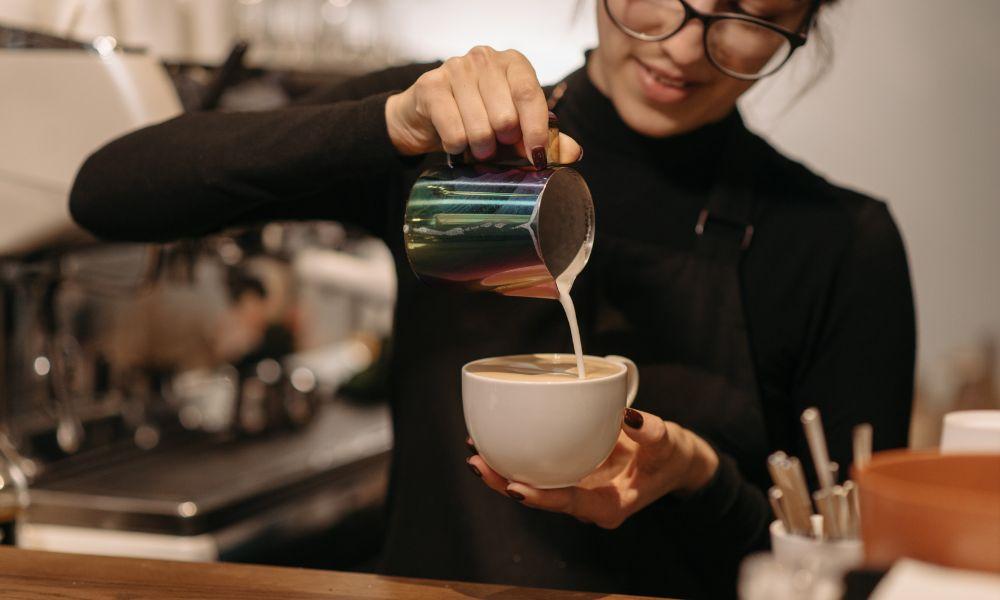Are you a coffee enthusiast seeking to elevate your daily cup of java? Prepare your taste buds for a rich and bold adventure as we explore the world of strong coffee made with espresso and milk. Learn the ins and outs of brewing potent espresso, enhancing the flavors of your coffee, and discovering exciting beverage variations for endless enjoyment.

The Art of Brewing Strong Coffee
It all begins with the most crucial ingredients: high-quality espresso and milk. The foundation of any robust coffee lies in the perfect extraction of concentrated flavors from the coffee grounds, and it’s no secret that espresso reigns supreme in this arena. With the combination of pressure and heat, we can unlock the depth and complexity within coffee beans to create a potent liquid gold like no other.
Choosing the ideal espresso machine is the first step to mastering the art of strong coffee at home. From budget-friendly manual machines to top-of-the-line automatic options, consider factors such as ease of use, pressure settings, and temperature control. No matter your preferred brewing technique, the key is to create an espresso shot with a balance of acidity, bitterness, and sweetness.
One essential aspect of brewing strong coffee is the coffee-to-milk ratio. The ratio will determine the intensity of the espresso flavor and the level of creaminess in your drink. A general rule of thumb is one part espresso to two parts milk, but personal preferences and the type of coffee beans used can influence the ideal ratio. Don’t be afraid to experiment and find the perfect balance for your taste buds!
Enhancing Flavor and Texture
Considering the importance of selecting the right beans for strong coffee cannot be overstated. Opt for bold coffee blends with a rich, full-bodied taste profile, such as dark-roasted Arabica or Robusta beans. This selection will ensure that the intense flavor of the espresso manages to cut through the milk, delivering that satisfying punch of strong coffee we all crave. Keep in mind that the coffee bean selection plays a pivotal role in the final taste, so choose wisely!
When it comes to milk options, the possibilities are nearly endless. From whole milk to almond, oat, or soy milk, each type of liquid will lend a different taste and texture to your strong coffee. Whole milk is known for its creamy, velvety texture, while non-dairy alternatives like almond milk can add a subtle nutty flavor to your drink. Feel free to go beyond the standard choices and explore the world of milk alternatives to find the perfect match for your taste.
Frothy milk is the secret ingredient that elevates our everyday coffee to an indulgent delight. Mastering the art of milk frothing requires patience, practice, and the right tools. Whether using a manual frother, an electric steam wand, or even a French press, learning the appropriate techniques to achieve a consistently creamy and velvety texture is essential. Experiment with different milk frothing methods, and don’t be shy to ask your friendly barista for tips and tricks! Remember, practice makes perfect.
Variations of Strong Coffee

In our quest to explore the spectrum of strong coffee beverages, we cannot overlook these popular espresso-based delights: macchiatos, lattes, cappuccinos, and flat whites. While they all share similarities, the nuances in their preparation and ratios set them apart, allowing us to enjoy an indulgent coffee experience tailored to our preferences.
- Macchiatos: This Italian classic consists of a shot of espresso with a small dollop of frothed milk on top. The name “macchiato” translates to “stained” or “spotted,” referencing the coffee’s appearance. With the smallest espresso-to-milk ratio of all the variations, macchiatos deliver a punch of both strength and flavor.
- Lattes: A popular choice amongst coffee aficionados, lattes are created by adding steamed milk to an espresso shot, topped with a small layer of milk foam. Lattes are recognizable by their smooth, rich texture, and subtle espresso flavor that doesn’t overwhelm the palate.
- Cappuccinos: An Italian classic, cappuccinos are made by combining equal parts espresso, steamed milk, and milk foam. This balanced mix allows for a full-bodied coffee experience without neglecting the smoothness of the milk.
- Flat Whites: Originating from Australia and New Zealand, flat whites are often considered the lovechild of lattes and cappuccinos. This drink features a double espresso shot with a smaller amount of steamed milk and microfoam, providing a more substantial coffee flavor compared to its latte counterpart.
The skillful art of latte art is not only visually appealing but can also contribute to the overall taste and experience of your beverage. Achieving the perfect latte art requires finely textured milk, a steady hand, and endless creativity. Test your skills by creating simple hearts, rosettas, or even more intricate designs to give your strong coffee a personalized touch!
As we continue this exciting journey of exploring strong coffee made with espresso and milk, keep an open mind and allow yourself to venture beyond your comfort zone. With dedication and a little experimentation, you can stimulate your taste buds and unveil the magical world of bold and invigorating flavors.
Expert Tips for Brewing the Perfect Cup

As you delve into the realm of strong coffee, you’re bound to learn a thing or two, embracing new techniques and skills to elevate your espresso and milk beverage to new heights. Here, we share some practical advice to help you brew the perfect cup of bold coffee at home:
- Water temperature is critical when brewing strong coffee. Aim for a temperature between 195°F (91°C) and 205°F (96°C) to extract the coffee’s full flavor potential while avoiding under- or over-extraction.
- The grind size should be fine for espresso-based drinks. However, bear in mind that a finer grind requires shorter extraction times, whereas a coarser grind demands a longer brewing time to extract flavors efficiently.
- Extraction time and pressure are also significant contributors to the overall taste profile. Most espresso machines operate at a pressure of 9 bars, and the ideal extraction time for a double espresso shot should take around 25-30 seconds. Adjust your machine accordingly to achieve optimum results.
- Troubleshooting issues such as poor crema, weak coffee, or an off taste can usually be resolved by adjusting brewing variables (water temperature, grind size, extraction time). Remember, practice makes perfect, and every master of strong coffee brewing has overcome setbacks along their journey.
FAQs
What makes a coffee “strong”?
Strong coffee refers to factors like the intensity of flavor, the caffeine content, and the richness of the taste. These elements can be influenced by the type of bean, brewing method, and coffee-to-milk ratios.
How does the strength of espresso differ from regular coffee?
Espresso is typically stronger in flavor and caffeine content compared to drip coffee. This is due to the higher pressure used during the brewing process, resulting in a more concentrated and bold coffee.
Can I make strong coffee without an espresso machine?
Yes, you can use brewing methods like the Moka pot or an AeroPress to create strong coffee at home without an espresso machine.
Which type of milk is best for achieving a creamy texture?
Whole milk generally yields a creamier texture, but experimenting with alternatives such as oat, almond, or soy milk can also deliver satisfying results.
What is the ideal coffee-to-milk ratio for strong coffee?
A general rule of thumb is one part espresso to two parts milk, but this ratio can be adjusted according to personal preferences and the type of beans used.
How can I balance the flavor of strong coffee?
Selecting the right coffee beans, fine-tuning brewing variables, and finding the perfect coffee-to-milk ratio can help you achieve a balanced flavor in your strong coffee.
Can I enjoy strong coffee if I prefer decaffeinated options?
Absolutely! Decaffeinated coffee is available in various flavors and intensities, allowing you to enjoy strong coffee even if caffeine isn’t your cup of tea.
Are there any health considerations associated with strong coffee?
Moderate coffee consumption (3-4 cups daily) has been associated with certain health benefits. However, individuals who may be sensitive to caffeine or suffer from certain health conditions should consult their healthcare provider before consuming strong coffee.
Conclusion
As we wrap up our exciting journey of exploring strong coffee made with espresso and milk, we hope the knowledge gained in this adventure has not only enriched your understanding but also sparked an unyielding curiosity. The versatility and satisfaction found in this type of coffee are truly unmatched, so don’t hesitate to experiment and personalize your strong coffee routine.
So raise your cup, savor the moment, and take a dunk into the vast ocean of bold and invigorating flavors that make strong coffee an essential part of our lives. Cheers to the enduring appeal and love affair that is a well-crafted, powerful, and delicious cup of coffee!
References:
- Espresso Guide by 1st in Coffee. Retrieved from https://www.1stincoffee.com/espresso-guide/
- Milk Alternatives for Coffee by The Coffee Bean & Tea Leaf. Retrieved from https://www.coffeebean.com/blog/our-menu/milk-alternatives-for-coffee-guide
- Coffee to Water Ratio by Handground. Retrieved from https://handground.com/grind/66-recipes-for-amazing-aeropress-coffee
- How to Make Espresso Without a Machine 3 Ways by Instantmania. Retrieved from https://www.instantmania.com/measuring-instant-coffee.html
- The Health Benefits and Risks of Drinking Coffee by Healthline. Retrieved from https://www.healthline.com/nutrition/coffee-good-or-bad